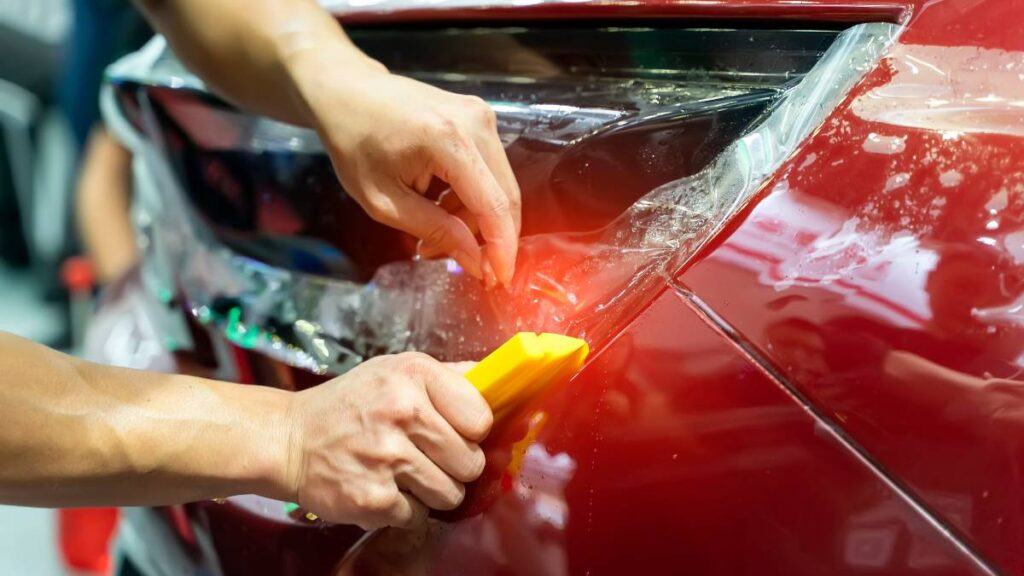When you invest, especially in something as valuable as your vehicle, it’s natural to wonder about the longevity and efficacy of that investment. One such worthy investment for car owners is Paint Protection Film or PPF. But how long can you expect it to protect your vehicle?
In this article, from the expert team at CCC Next Gen, we will explore more about the factors that influence the lifespan of PPF and share some tips on maximizing its benefits.
What does PPF do?
Paint Protection Film, commonly known as PPF, is a transparent, durable urethane film applied directly onto a vehicle’s paint. Its primary function serves as a shield, safeguarding the car’s surface from potential damages like minor chips, scratches, and stains often caused by road debris, abrasive dirt, bird droppings, and even UV rays. In essence, PPF is like an invisible armor that maintains the vehicle’s pristine appearance and protects its paint from the daily challenges of the road.

How do you know when PPF needs to be replaced?
Over time, even the best PPF may exhibit signs of wear and tear. Indicators that your PPF might need replacement include:
Yellowing or Discoloration
Although high-quality films resist yellowing, prolonged exposure to the elements can lead to slight discoloration in some films.
Lifting or Peeling Edges
Over time, the edges of the film might begin to lift or peel away, especially if exposed to regular high-pressure washing.
Cracking or Brittle Texture
If the film becomes brittle or starts to crack, it’s a clear sign that it has reached the end of its lifespan.
Loss of Clarity
The film’s hazy appearance or reduced clarity indicates it may be time for a change.
How long does PPF last?
Like many things in life, the lifespan of PPF isn’t a simple number; several factors influence its durability.
Quality of the PPF
The quality of the film directly correlates to its lifespan. Higher-end, premium films often come with advanced protective features, UV inhibitors, and self-healing properties, granting them a longer life. Top-tier PPF can last upwards of 7 to 10 years. In contrast, essential or budget PPF might begin showing wear within 3 to 5 years. Investing in a high-quality film can, in the long run, save both time and money.
Environmental Conditions
Exposure to the elements plays a significant role in the wear and tear of PPF. Vehicles in regions with harsh sun might experience quicker degradation due to UV radiation, leading to discoloration or yellowing. On the other hand, cars in areas with frequent sandstorms or road salt can see accelerated physical wear on the PPF. A region’s climate and specific environmental challenges can either extend or reduce the film’s expected lifespan.
Maintenance and Care
Regular cleaning and using the right products can make a world of difference. Harsh chemicals or abrasive tools can damage the film’s surface. Proper maintenance, including gentle washing, using PPF-friendly products, and regular inspections, can add years to the film’s life. On the flip side, neglect can expedite its aging.
Installation Expertise
How the PPF is applied is as crucial as the film itself. Expert installation ensures that the film adheres appropriately without bubbles or imperfections, which can be potential weak points. Poorly applied PPF can peel, lift, or degrade faster, emphasizing the need for skilled, professional installation.
Vehicle Usage
How and where the vehicle is used can influence the lifespan of PPF. A car that sees frequent off-road action travels on gravel roads, or is subjected to regular long-distance travel might experience faster PPF wear due to increased exposure to debris and potential abrasions.
Parking Habits
Believe it or not, where you park your car regularly can impact the longevity of your PPF. Cars consistently parked outdoors, exposed to direct sunlight, bird droppings, and tree sap, can face quicker PPF degradation. Conversely, vehicles often parked in garages or shaded areas are shielded from many environmental aggressors, helping prolong the life of the film.

How to increase the lifespan of PPF
To ensure you get the maximum life out of your PPF, consider the following tips:
Regular Cleaning
Wash your vehicle regularly to prevent contaminants from settling on the film, which can degrade its quality.
Avoid Harsh Chemicals
When cleaning, use PPF-safe products. Harsh chemicals can damage the film’s surface and reduce its lifespan.
Gentle Drying
After washing, use a soft microfiber towel to dry your vehicle, reducing the risk of scratching the film.
Park Strategically
If possible, park in shaded areas or garages to reduce prolonged exposure to direct sunlight and environmental contaminants.
Annual Inspections
Have a professional inspect your PPF annually to check for signs of wear and ensure it remains in optimal condition.
While PPF is undeniably robust, its longevity is interwoven with various factors ranging from the quality of the film to the car owner’s habits. Awareness of these factors and making informed decisions can help ensure that the protective shield you place on your vehicle stands the test of time, safeguarding your prized possession for years.
Introducing premium grade PPF by CCC Next Gen
For all inquiries and product orders, contact 0161 529 5855
Gmail: [email protected]


